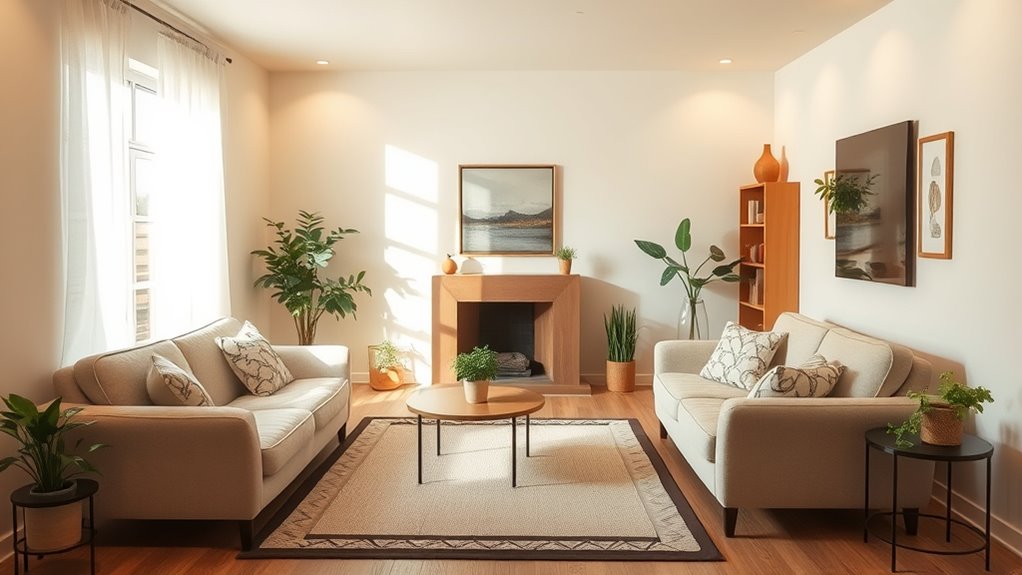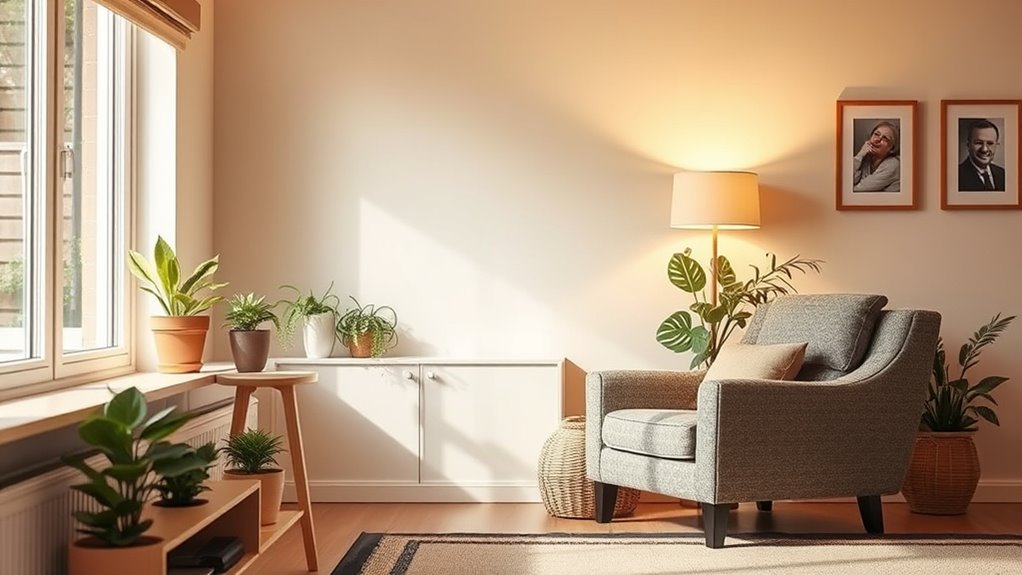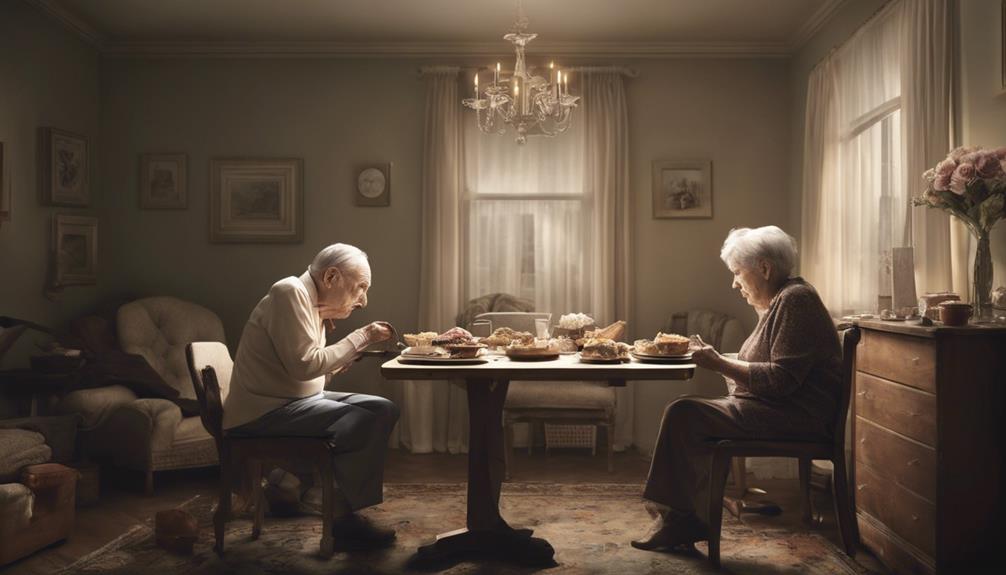To minimize dementia triggers, you should create a calm and familiar environment by reducing clutter, adjusting lighting to avoid glare, and adding visual cues for easy navigation. Remove tripping hazards, secure cords, and install grab bars for safety. Keep routines consistent and place essentials in predictable locations to reduce confusion. Using familiar objects and calm colors helps promote security. Continuing to explore these strategies can help you craft a supportive, safe space for loved ones.
Key Takeaways
- Use consistent lighting and reduce background noise to create a calm, sensory-friendly environment.
- Implement clear visual cues and signage to aid navigation and orientation within the space.
- Remove hazards and add safety features like grab bars and nightlights to prevent falls and injuries.
- Maintain familiar objects, routines, and designated spaces to reinforce memory and reduce confusion.
- Keep the environment stable, clutter-free, and soothing to promote security and independence.

Dementia can considerably impact daily life, but you can create an environment that reduces its triggers and promotes safety. By making thoughtful sensory adjustments and safety modifications, you help minimize confusion and frustration, making daily routines more manageable. Sensory adjustments involve modifying lighting, sound, and visual cues to create a calm, familiar environment. For example, you might use soft, consistent lighting to prevent startling glare or shadows that can cause disorientation. Reducing background noise from televisions or radios can also help the person focus and feel less overwhelmed. Consider using calming colors and clear signage to guide them around the home, reducing anxiety caused by unfamiliar or cluttered spaces. These sensory adjustments help create a soothing atmosphere where they can feel secure and oriented. Additionally, incorporating familiar objects and routines can help reinforce memory and a sense of familiarity.
Safety modifications are equally essential and should be tailored to the individual’s specific needs. Remove tripping hazards like loose rugs or clutter that could cause falls, and secure loose cords or furniture edges. Installing grab bars in bathrooms and handrails along hallways provides additional support, especially for those with balance issues. You should also consider locking cabinets or doors containing dangerous items, such as sharp objects or medications, to prevent accidents. Bright, contrasting colors on stairs or steps can make them more visible, reducing the risk of falls. Adding nightlights in hallways and bathrooms ensures safe navigation during nighttime hours, preventing disorientation and falls. These modifications not only protect the individual physically but also foster independence by allowing them to move around with confidence. Incorporating visual cues can further assist in navigation and orientation within the home.
Creating a safe environment also involves establishing routines and reducing clutter to minimize confusion. Keeping daily essentials in familiar, consistent locations helps the person find what they need without frustration. Use visual cues or labels to identify rooms or objects, making navigation easier. Maintaining a predictable routine reduces anxiety by providing structure, which is crucial for someone with dementia. Additionally, ensure that the environment remains stable over time, avoiding frequent rearrangements that could disorient them. Regularly reviewing safety modifications and sensory adjustments allows you to adapt as the person’s needs change, ensuring ongoing safety and comfort.
Frequently Asked Questions
How Can Technology Assist in Creating a Dementia-Friendly Environment?
Technology can help you create a dementia-friendly environment by using assistive technology and smart home devices. These tools can remind you about medications, guide you with voice-activated assistants, and automatically control lighting or doors to reduce confusion. With smart technology, you can enhance safety and independence, making daily life smoother and less stressful for someone with dementia. This proactive approach helps minimize triggers and supports their well-being.
What Are Cost-Effective Modifications for Home Safety?
You can make cost-effective home safety modifications by improving home security and rearranging furniture. Install simple locks or alarms on doors to prevent wandering, and add motion sensors or night lights to enhance visibility. Rearrange furniture to create clear, wide pathways, reducing fall risks. These small changes help your loved one navigate safely, boost confidence, and minimize triggers for confusion or accidents without breaking the bank.
How Do Environmental Changes Impact Dementia Progression?
Think of your loved one’s mind as a delicate garden; environmental changes act as gentle rain or harsh droughts. By enhancing sensory stimulation and simplifying spatial navigation, you can slow dementia’s march. Clear pathways and familiar cues help maintain independence, while stimulating environments nurture mental engagement. Your thoughtful adjustments create a sanctuary where cognitive decline slows, and moments of clarity bloom, turning a fragile mind into a resilient garden.
Are There Specific Lighting Solutions That Help Reduce Confusion?
Yes, specific lighting solutions can help reduce confusion. You should focus on lighting design that provides consistent, bright, and even illumination to minimize shadows and glare. Incorporate visual cues like color-coded lighting or clear pathways to guide movement and signal important areas. By adjusting lighting to be comfortable and predictable, you help reduce disorientation, making it easier for someone with dementia to navigate safely and confidently.
How Can Caregivers Personalize Environmental Adjustments?
Like tuning a delicate instrument, you can personalize environmental adjustments through thoughtful strategies. Use familiar objects, photos, and colors that resonate with their past, creating a comforting space. Involve the caregiver by observing what calms or stimulates them, then tailor the environment accordingly. Your active involvement guarantees the surroundings reflect their preferences, reducing confusion and anxiety while fostering a sense of security and familiarity.
Conclusion
By transforming your environment, you could turn chaos into calm, confusion into clarity, and overwhelm into peace. Every small change you make might be the difference between wandering lost in a maze or confidently steering your day. Imagine creating a space so soothing that it shields your loved ones from every trigger, making daily life feel like a gentle breeze instead of a storm. Your efforts could truly revolutionize their world, one safe step at a time.









